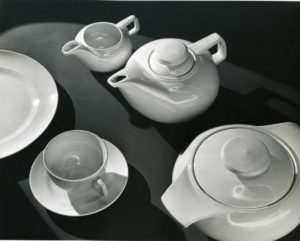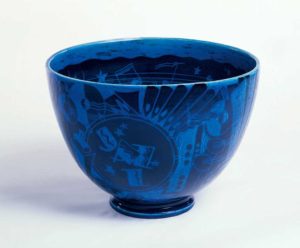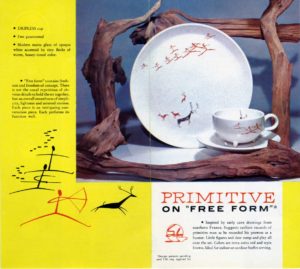American Ceramic Designer Viktor Schreckengost
EMERGING SCHOLARS > SUMMER RESEARCH GRANTS
Catherine Acosta,
MA Candidate, Design and Curatorial Studies, Cooper-Hewitt Parsons
Generous support from the Decorative Arts Trust and the Marie and John Zimmermann Fund allowed me to spend a week researching the history of the pottery industry in eastern Ohio. My master’s thesis focuses on American industrial designer and artist Viktor Schreckengost and his mid-20th-century dinnerware. At stops in Sebring, Salem, East Liverpool, and Cleveland, I poured over rare archives and catalogued never-before-seen materials.
Designing everything from trucks to dinnerware to lawn chairs, Schreckengost was a successful designer in many fields. His casual dinnerware services for both the American Limoges China Company in the 1930s and for the Salem China Company in the 1940s and 1950s were sold and distributed across the country. His bicycle and toy designs for the Murray Ohio Manufacturing Company achieved mass-appeal, after the firm became Sears, Roebuck and Company’s premiere bicycle manufacturer in 1938.
Schreckengost was born in Sebring, founded as a pottery production center in 1900. His father and both brothers were potters. Sebring helped define Schreckengost’s artistic identity. He spent 1929 studying ceramics at the Kunstgewerbeschule in Vienna with Michael Powolny, where he focused on sculpture and handthrown vessels. The influence of this training is best seen in his dinnerware designs, such as “Manhattan” for American Limoges in 1935, which was his first commercially successful dinnerware pattern.
Schreckengost produced iconic interpretations of Jazz Age design, including the acclaimed bowls “The New Yorker” and “Cocktails and Cigarettes” for the Cowan Pottery Studio. While his time at Cowan was rather brief (1930–31), the experience was imperative to his creative output as a ceramicist and an industrial designer. His first commercial dinnerware commission came through Cowan, and he employed his Viennese training and experimented with different techniques for producing and decorating forms. Throughout Schreckengost’s career, his style was highly modernistic, borrowing the aesthetic language of the avant-garde but applying it to comprehensible forms and subjects. While his mid-century dinnerware forms like “Tempo” and “Free Form” are sculptural and veer toward abstraction, this approach was a response to the biomorphic and sculptural forms of Russel Wright and Eva Zeisel on the marketplace.
During the 1930s and 1940s, Schreckengost was well regarded for his ceramic sculptures alongside his design work, winning multiple awards and exhibiting artworks at the Cleveland Museum of Art and the Syracuse Museum of Fine Art among others. After Schreckengost developed the “Manhattan” line for American Limoges, prominent art potter and designer Frederick Hurten Rhead of the Homer Laughlin China Company praised Schreckengost for his simple yet sophisticated modern design, quite a compliment from a competitor working for one of the largest American dinnerware manufacturers in the country.



